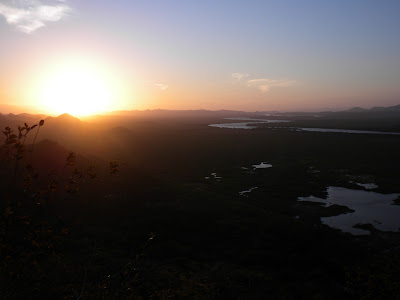 Santa Rosa was VACATION!! No projects here at the beach. Absolutely the most gorgeous beach ever; maybe 4 or 5 miles end to end with mountains wrapping around the ends to make a little bay. It was like we were in a movie. It was so remote; we hiked 11km in to the beach and ran straight into the ocean. Salt water never tasted so good. That afternoon the whole group walked all the way down to one end of the beach laughing about how we finally had some time to relax and we couldn't sit still.
Santa Rosa was VACATION!! No projects here at the beach. Absolutely the most gorgeous beach ever; maybe 4 or 5 miles end to end with mountains wrapping around the ends to make a little bay. It was like we were in a movie. It was so remote; we hiked 11km in to the beach and ran straight into the ocean. Salt water never tasted so good. That afternoon the whole group walked all the way down to one end of the beach laughing about how we finally had some time to relax and we couldn't sit still. We camped in 4 person tents in a campground right behind the beach. It was right in the middle of turtle breeding season and there was no moon, so every night there were turtles coming up to build nests and lay eggs, and every afternoon turtle nets were hatching. We saw both within 12 hours. The first night we walked down to the other end of the beach with a guide who studies the turtles and tags/tracks them. It was a late night but totally worth it...we saw an Olive Ridley laying eggs. She lays arond 70 eggs and then spends at least 40 minutes covering up and patting down the nest in this circular dance--she was so careful! You couldn't even tell where the nest was when she was done patting it down. Watching her return to the ocean under only the starlight was one of the most beautiful things I've ever seen. The next day we saw Olive Ridley and Green turtule babies hatching.
We camped in 4 person tents in a campground right behind the beach. It was right in the middle of turtle breeding season and there was no moon, so every night there were turtles coming up to build nests and lay eggs, and every afternoon turtle nets were hatching. We saw both within 12 hours. The first night we walked down to the other end of the beach with a guide who studies the turtles and tags/tracks them. It was a late night but totally worth it...we saw an Olive Ridley laying eggs. She lays arond 70 eggs and then spends at least 40 minutes covering up and patting down the nest in this circular dance--she was so careful! You couldn't even tell where the nest was when she was done patting it down. Watching her return to the ocean under only the starlight was one of the most beautiful things I've ever seen. The next day we saw Olive Ridley and Green turtule babies hatching.
 After we left Santa Rosa we arrived at Monteverde, which is a montane cloud forest. Everything here is so lush; someone noted "it's like a greenhouse!" There are orchids, ferns, bromeliads, and super colorful flowers everywhere. It was mildly terrifying to get here in our monster (stick shift) bus on the super steep, narrow, windy roads/bridges, but it's been incredibly worth it. We've seen hummingbirds, waterfalls, plants growing wild in the forest that many people pay lots of money for at a flower shop...but strangely, not too many clouds. It should be really foggy with nearly constant precipitaition, but it's been sunny every day we've been here. Apparently it was sunny all of last year's stay also. It really shows you signs of climate change--it's scary to think this incredibly unique habitat might be gone soon.
After we left Santa Rosa we arrived at Monteverde, which is a montane cloud forest. Everything here is so lush; someone noted "it's like a greenhouse!" There are orchids, ferns, bromeliads, and super colorful flowers everywhere. It was mildly terrifying to get here in our monster (stick shift) bus on the super steep, narrow, windy roads/bridges, but it's been incredibly worth it. We've seen hummingbirds, waterfalls, plants growing wild in the forest that many people pay lots of money for at a flower shop...but strangely, not too many clouds. It should be really foggy with nearly constant precipitaition, but it's been sunny every day we've been here. Apparently it was sunny all of last year's stay also. It really shows you signs of climate change--it's scary to think this incredibly unique habitat might be gone soon.Maddy and I did a really cool project here on hummingbird territoriality that we'll try to explain later, but now I'm off to breakfast and then to our next site: Cuerici. We probably won't have internet access until the first or second week of February, so see you then!
-Madi















